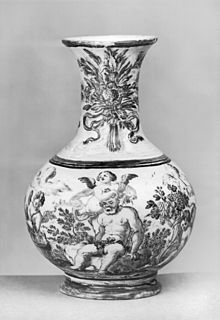| Revision as of 17:38, 9 July 2012 editKeithh (talk | contribs)Autopatrolled, Extended confirmed users, Pending changes reviewers21,067 edits create page | Revision as of 17:48, 9 July 2012 edit undoKeithh (talk | contribs)Autopatrolled, Extended confirmed users, Pending changes reviewers21,067 editsm →Biography: disambNext edit → | ||
| Line 3: | Line 3: | ||
| ==Biography== | ==Biography== | ||
| Grue was born in ], into a family of ] potters and painters. In 1716, after studying for a time in ], he traveled to ]. There Grue produced many ceramic works, especially plates decorated with landscapes or ] in the center, and tendril or ] borders. Wares were also often signed and dated. In 1736 he returned to his hometown and continued to work until his death in 1746.<ref name="ref1">{{cite web|url=http://www.answers.com/topic/grue-francesco-antonio-xaverio-1|title=Francesco Antonio Xaverio Grue Brief Biography|accessdate=2012-07-09}}</ref> |
Grue was born in ], into a family of ] potters and painters. In 1716, after studying for a time in ], he traveled to ]. There Grue produced many ceramic works, especially plates decorated with landscapes or ] in the center, and tendril or ] borders. Wares were also often signed and dated. In 1736 he returned to his hometown and continued to work until his death in 1746.<ref name="ref1">{{cite web|url=http://www.answers.com/topic/grue-francesco-antonio-xaverio-1|title=Francesco Antonio Xaverio Grue Brief Biography|accessdate=2012-07-09}}</ref> | ||
| ==References== | ==References== | ||
Revision as of 17:48, 9 July 2012

Francesco Antonio Xaverio Grue (1686-1746), was an Italian potter and painter.
Biography
Grue was born in Castelli, Abruzzo, into a family of maiolica potters and painters. In 1716, after studying for a time in Urbino, he traveled to Naples. There Grue produced many ceramic works, especially plates decorated with landscapes or putti in the center, and tendril or festoon borders. Wares were also often signed and dated. In 1736 he returned to his hometown and continued to work until his death in 1746.
References
- "Francesco Antonio Xaverio Grue Brief Biography". Retrieved 2012-07-09.
This Italian artist–related article is a stub. You can help Misplaced Pages by expanding it. |